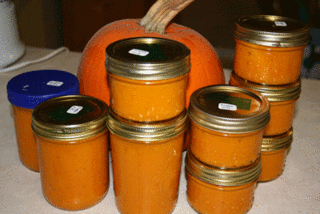Q&A- My Grocery Budget
There were so many great questions asked in the comments in my recent post How My Grocery Budget Works, that I felt the need to address them in a separate post. Here goes…
What is your dill pickle recipe?
 I’ll post both this recipe, and our favorite Bread and Butter pickles recipes up within the next week! Both are cold-pack, refrigerator pickles and so easy to make. 🙂
I’ll post both this recipe, and our favorite Bread and Butter pickles recipes up within the next week! Both are cold-pack, refrigerator pickles and so easy to make. 🙂
(This pic is of Abbie last summer, with a bunch of our delicious pickling cucumbers from the garden)
Kelly had several questions:
First, do
you ever eat out (at restaurants, either with your husband or as a
family?) Fast food?
Yes, we do eat out sometimes. Fast food is a rarity and more of an emergency purchase, when we’re unexpectedly away from home for a long time and simply need something to tide us over and nothing else is available. We try as hard as we can to avoid it, and will sometimes just pop into a grocery store if we can, to get some healthier munchies instead, or plan ahead to bring snacks from home that travel well. But we do go out to nicer restaurants sometimes, for dates with my husband and once in a while with our kids or with family members for celebrations. This comes out of the Recreation portion of the budget, rather than our food budget.
When you eat at others homes, are you particular
about which items prepared you will eat (for example, if something is
pre-packaged or doesn’t fit within your daily eating system) or do you
eat everything (except things you have sensitivities to, obviously)?
When we are being graciously hosted by others, we will generally eat what is set before us, unless it is something that we are truly not able to eat (like a sensitivity). Our toddler can’t have wheat, for example, so we avoid that even when in another’s home. If asked, we will specify a few things that we can’t or prefer not to eat (non-kosher meats, wheat, a lot of sugar, etc.) but usually we just accept what we are given. For more of my thoughts on this, see this post on Eating Healthy in Social Situations.
Also, do you add extra to other categories when your produce expenses go down due to your garden producing?
I think I didn’t explain this very well in my post. When my produce expenses go down, my fruit/berry expenses go up. This is how I am able to purchase such a large amount of fresh fruit for freezing and canning every summer. Otherwise, it would totally bust my budget!
From Emily– One thing I would love to hear more about is how you freeze/can/preserve your fruits, veggies, tomatoes.
 This question was repeated several times. Here are a few links to previous posts on this topic:
This question was repeated several times. Here are a few links to previous posts on this topic:
Pumpkin Canning
Canning Resources (this post links to the 4 books that I have used for the bulk of my preserving- not just canning, but also freezing and dehydrating as well)
Why I’ve been so busy
I will have to share more on this as I do it this summer. These posts give you just a little idea of what I do with the summer bounty. Truth is, I’ve only been canning and preserving these foods for a few years, and have only recently begun to feel really comfortable with the process. If you’re interested, I promise I’ll make it more of a blogging priority as I go along this year. 🙂
Erin asked: We are on a bi-weekly pay
schedule. How do you suggest I budget for bigger ticket items that I do
not purchase on a regular basis (such as 50 lbs. of wheat berries at
$40.45)? On weeks where I have to buy one of these items, I end up
having to skimp on the usual purchases and we eat a lot of beans and
rice for two weeks. 🙂 Any suggestions?
I totally understand where you’re coming from, because I used to have to do that with my budget as well. What changed is that we’ve put ourselves on the You Need a Budget system, and part of that is that we live on last month’s income. We are able to budget for the current month on a monthly basis rather than bi-weekly (which is how we are paid also). This let’s me look at my month with the full $400 at a time, instead of only $200 for half of the month. It makes it easier to make large purchases, and then simply split up the remaining money that I have. If at all possible, I would talk to your husband about it and see if there’s a way to start each month with your full amount, instead of only getting it every second week. This will give you more freedom to make big purchases without having to scrimp as much later on.
Another way to do it would be to start setting aside small amounts of your budget for the purpose of bigger purchases. This is how I buy my grass-fed beef, because my monthly budget could never sustain it. I put aside $20-40 each month as I am able, and gradually I have enough money to make the big purchase. Before we switched over to a monthly budget, this was the way that I would save up to make most of my larger purchases.
So, instead of wheat…what do you serve? 🙂 (asks my sweet friend Lylah)
 We primarily use kamut, which is an ancient form of wheat. It functions similarly (though it has a lower gluten content), and generally doesn’t cause sensitive or allergic reactions in most people. Before kamut, we used a lot of spelt, which is a very similar grain (also a form of wheat), but since grain prices have risen so much, I find kamut to be much more affordable.
We primarily use kamut, which is an ancient form of wheat. It functions similarly (though it has a lower gluten content), and generally doesn’t cause sensitive or allergic reactions in most people. Before kamut, we used a lot of spelt, which is a very similar grain (also a form of wheat), but since grain prices have risen so much, I find kamut to be much more affordable.
Other grains that I make a lot of use of include: oats (steel-cut and rolled, primarily), rye (in my breads), barley (great for non-bread baking and also for pancakes and waffles), and sometimes millet or brown rice (mostly when baking for those who are gluten free).
Jena said- I was wondering how much that milk share would cost. Wouldn’t it be easier to own the cow?
I tend to think so, though my husband begs to differ! LOL! Having a cow, or even a goat, is simply not possible for us in this season, with where we live. One day, maybe… 🙂
Fruit leather? I’m intrigued! How do you make fruit leather? (says Audrey)
Oh, it’s soooo easy and cheap to make! Here are my simple directions!
More Q&A to come soon…





I am really really interested in you bread recipes and just how you use Kamut. Do you grind it just like wheat or buy it already ground? We are having to go wheat free starting next week when I can get an alternative to see if some issues we are having are wheat related. I was really upset about the thought of no bread..LOL. Please share more on this. Please.
I would be interested in hearing more about canning in the future! I know a few basics, having helped my mom growing up, but now, (being a fairly new wife) I’d like to get started on doing some myself.
Love your blog!
Thanks for answering all my questions! Here’s another: are your wheat sensitivities Celiacs? My mom and both my sisters have this, and while I don’t have any sensitivities, I do worry that my daughter may develop them.
wow!~ great post–When I am not nursing, I have a gluten intolerance and we have to eat a lot of brown rice, quinoa, etc. in lieu of wheat, however, I am one of the lucky few whose symptoms go away during nursing a baby. I have asked my doctor about this and she said that some chronic conditions will be absent during pregnancy or nursing, which is bizarre (even things like joint pain will go away for the season). Luckily, during the year I can eat it, so it is a lot cheaper for our budget, BUT come weaning time, it is back to expensive pasta! I have never heard of kamut, though, and think I’ll readup on it.
PS-I am diagnosed with celiac, not just an intolerance, I can’t eat any!
i would love to know the best resource for finding out how to buy grass fed meat from a cow! i know i can ask around, but we are new to the area where we live. a few people i know have purchased beef and it was very very fatty and just plain yuck. i want deliciousness. your thoughts?
How ironic–I just decided to borrow my mom’s dehydrator for the week and wanted to make fruit leather–however, here’s a question- Her’s is an old one (she can’t find the book that goes with it nor does she remember how to make the leather) that only comes with the mesh layers…if I were to put puree in it it would fall through! Have you ever put cling wrap or something on the bottom? Does that work just the same as what you have? Any tips would be great!
Sarah M
Stephanie,
I just found you over the weekend via simplemom. Yeh! At the same time I’m reading Nourishing Traditions and it’s all coming together. So thanks! I just bought the e-book and am ordering raw milk. My husband and kids are lactose intolerant and am wondering if the enzymes in raw milk will help them. Anyway, lots to learn. Take good care and blessings.
thanks for the answers and I look forward to more!
By the way I have broken my budget down like you did in your post and I found it gave me more insight into where our money was going, and enabled me to make a few changes, so that is great! Thank you for sharing.
I also (finally) found a source of more affordable free range eggs that I can get on a fairly regular basis! I am thankful for that.
Jamie, here’s a post with some good places to start your search:
https://keeperofthehome.org/2008/12/nutritional-foundations-finding-high-quality-sources-for-a-whole-foods-diet.html
I would suggest the Eat Wild and Local Harvest would be among the better links to begin with. Once you start finding sources, just ask around to get a feel for whether they are really good or not. Some stores will sell smaller amounts of meat from a store front as well, which lets you try it out before you make a larger purchase.
Sarah M, if you’re celiac, kamut won’t work for you unfortunately. It’s lower in gluten, but it still has some. It’s better for people who are sensitive to wheat specifically, as opposed to gluten.
Also, in regards to the dehydrator, you do need to use the plastic, flex sheets (sometimes called Tefflex or Paraflexx or other names). I actually have tried with plastic wrap and with parchment paper, and neither worked because of the heat of the dehydrator. You can often buy the sheets online, places like Ebay and Amazon, and possible for a good deal if the one you have is older and not in high demand. Hope you’re able to make some fruit leather!
Sarah, welcome and good for you! That’s so awesome!
Nola, I’m really glad it was helpful for you, and yay for finding affordable eggs! 🙂
I learned a lot from this post. Thanks!
Ooh, I love Kamut!
Just FYI for folks who are wondering, we’ve found our grass-fed beef to be much LESS fatty than typical storebought beef– and the fat has a nicer flavor. After you get used to it, storebought conventional beef tastes really weird.
How do you get by only buying fresh produce every 2 weeks? Does it stay fresh? Do you eat fresh fruit every day?
Jen, I try to work my meal plan around the foods that will go bad the fastest. This means that we’re more likely to have leafy salads in the first week (if it’s not summertime when my garden is growing). Other items like tomatoes, mushrooms, asparagus, etc. are eaten closer to buying time, since I know they won’t last. Some vegetables, like celery, carrots, potatoes, peppers (usually), squash, etc. will last the entire time.
We eat fresh fruit most days. I’ve found that fruits like apples, pears, oranges, lemons, etc. if they’re kept in the fridge and not on the counter once they’re ripe. Bananas not so much, so we eat those while they’re nice, then freeze them when they’re too ripe. If we’re running low on fresh fruit at the end, we just rely more on frozen berries or home canned fruit, but it’s usually not a big problem. Juicier fruits like apricots, plums, and other summertime tree fruits never last for 2 weeks (though they’ve come close sometimes) but we usually eat them faster anyways.